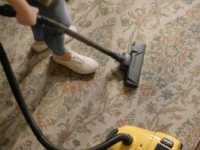Guest post by Stella Myers
If you want your everyday life to run smoothly, keeping your home clean and tidy is important. You can either do the cleaning yourself or hire a cleaner through a professional house cleaning service. There are plenty of websites and agencies out there to use. There are even services focused on specific areas of London. for example, if you live in Tooting you can book a Tooting cleaning service. However, if you prefer to be the one to do the cleaning then here is a 7-step plan to follow to ensure a smarter clean-up of your house.
Here is a 7-step plan to follow to ensure a smarter clean-up of your house.
1. Have a Cleaning Routine
Organization and discipline are the keys to keeping the home tidy. If you adhere to a maintenance routine and clean the whole house once a week, you’ll find that your easy cleaning takes less time. Then you will get caught up in the things that you don’t have to do every week. You should keep a running list of them so they don’t go unnoticed.
For instance, the list may look like this for your kitchen cleaning:
- The interior of the refrigerator
- Kitchen appliances
- The kitchen cabinets
- The dishes
- Light fixtures
- The stove
- The oven
- The kitchen walls
- The kitchen floor
2. Clean the Bathrooms
Remove everything from the tubs and showers and spray them with your preferred bathroom cleaner before soaking them. Carry out the same procedure for the toilet bowls. Place the cleaning supplies in the container and give them a good swish with the hose. Take a garbage bag with you to clean all of the trash containers at this time.
3. Replace the Bedding
Collect all of the clean sheets and pillowcases you’ll need for each room. Remove the current sheets and make the bed. Take all of the soiled sheets to the washing room. Before dusting the walls in the bedrooms, make sure the beds are made. This keeps dust out from under the blankets. If the ceiling is especially dirty, you might want to drape a sheet over the freshly made bed while dusting the ceiling.
4. Clean the Ceilings and Walls
Begin from the cobwebs and dust on the walls, corners, and door jams and move methodically around each room. Meanwhile, your bathroom cleaning products are doing their work. Work your way down the walls until you reach the baseboards. For corners, a Webster serves well, but I think it’s best if you cover it with a cloth—the cloth is simply better at cleaning away those sticky webs.
5. Complete the Bathrooms
You’ll be able to complete the bathrooms until you’ve cleaned all the webs and dust. When you’ve finished washing, return all shampoos and other items to the bathroom, clean the vanity and mirror, scrub the sink, wipe the cabinets and polish all fixtures. Next, clean the toilet bowls with bleach, water, and paper towels, and the bathroom floors with a mop.
6. Dust
You’re able to resume dusting now that the difficult part is over.
- Furniture: Remove all small objects from shelves and tabletops, starting at the top and working your way down. Use whatever oil or wax you like to polish wood surfaces. Dusting books on shelves thoroughly is just one of those tasks that you should do every few weeks. It would be best if you dusted the racks, backs, and tops of the books once a week, but it’s also a safe idea to pull all the books off the shelf and dust them individually once in a while.
- Lamps: If the lampshade is made of cotton, cut it and vacuum it separately. Wipe the lamp clean and raise it to clean beneath it.
- Other objects: Before placing things back on the shelves and coffee tables, wipe them down. To avoid smearing certain objects with oil or wax, brush them with a different cloth dampened with a cleaner spray or anything similar.
7. Clean the Floors
When you’ve finished dusting, it’s time to vacuum. Vacuum in the following order:
- Lampshades: Vacuum the lampshades and reinstall them.
- Furniture: Upholstered chairs can be vacuumed at least once a week.
- Floor edges and corners: Start with the corner tool to get the floor’s edges and corners. Then it’s time to tackle the rugs and carpets.
- Hard floors: You can use a canister vacuum cleaner or an upright vacuum. Use a roller-head sponge mop and bucket if the linoleum or tile floors are dirty with stuck-on mud. It would help if you used a wet cloth to clean a difficult spot by hand. Follow the manufacturer’s cleaning instructions for hardwood or laminate flooring.
If you have easy access to anything you need, it will make your work easier. Using a storage holder or a bucket with a handle to transport the supplies from room to room is a smart idea.





